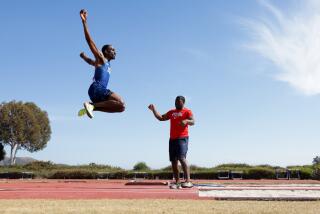By vibrating the muscles, engineers produce a better prosthetic hand

A study participant triggers the robotic hand to open and close. [P.D. Marasco et al., Science Translational Medicine (2018)]
Consider for a moment the welter of unconscious judgments and adjustments you make every time your hand reaches for an object — say, a tall drink of water. Eyes, muscles, brain and digits coordinate with exquisite speed and subtlety to ensure the cup is reached, grasped around the middle, held gently but firmly, and drawn — upright and at a pace that won’t make waves — to your mouth.
Now imagine performing that quotidian task with a prosthetic hand, or a disruption in the flow of signals between hand and brain. Even with the mechanical means to clutch a glass, grasping it will require constant visual oversight and a lot of effortful calculations. Without all that tactile feedback from your muscles and digits, mistakes, frustration and a sense of loss will probably ensue.
With this in mind, researchers from the Cleveland Clinic’s Lerner Research Institute asked how, in effect, they could improve the user experience for amputees fitted with a prosthetic hand.
Their answer was as simple in theory as it was complex in execution: To feel in fuller command of an artificial appendage, they found, the user of a prosthetic limb may just need a little buzz.
Cleveland Clinic’s Paul Marasco and his colleagues devised a robotic system that, with every movement of an artificial hand, would deliver vibrations to the muscles in a user’s arm that controlled that hand.
The location and intensity of those vibrations created for amputees an illusory “kinesthetic” sense that they were moving their own hand. Study subjects learned within minutes to use the vibratory feedback to more deftly move their mechanical hand, to better sense its position in space, and to tighten and loosen their grip on objects as needed.
In some cases, no eyes needed. Once they got the system of feedback vibrations, participants were able to carry out a wide range of hand movements blindfolded.
“Establishing a sense of agency for these devices will help amputees intrinsically feel in control of their artificial limbs, a key aspect of user acceptance,” Marasco and his colleagues reported Wednesday in the journal Science Translational Medicine.
In the near future, the authors wrote, this approach could inspire wearable or other feedback systems that might allow amputees to guide and control their prosthetic limbs intuitively, restoring the luxury of unconscious movement.
Giving users a greater sense that they are the instigators of movement will become more important as the technology of prosthetic limbs advances, the authors wrote. Although many of those artificial limbs will be capable of independent movement, users are unlikely to accept them if they don’t feel like natural extensions of their wish to move.
To devise a menu of vibrations that would signal 22 separate movements of the hand, the researchers largely worked with six participants who had had an arm amputated. All had undergone targeted nerve reinnervation, a procedure that enables the establishment of a link between brain and machine by redirecting amputated nerves to remaining muscles.
With a hand-held vibration unit, they delivered a slight buzz (between 70 and 110 hertz worked best) to muscles in the portion of the upper arm — the biceps, triceps, brachialis and pectoralis muscles — that remained intact. Using their intact hand on the opposite side, the participants reported which complex movement they most associated with the buzz they felt.
The researchers also worked with able-bodied volunteers to map the most effective system of feedbacks. Some of the connections between vibration and hand movements appeared to differ little from person to person. The researchers found that certain vibration spots routinely elicited the cylinder grip (or fist closing), the tripod grip (in which the thumb, index finger and middle finger come together) and the classic fine pinch of the thumb and pointer finger. Combinations of feedback vibrations elicited some other manual movements.
“We’re actually able to to use the perceptual illusion of movement to provide amputees with the sense that their hand is moving in very complex and naturalistic ways,” Marasco said.
Although it may first help amputees who use prosthetic limbs, the approach his team used may someday help patients whose movements have been impaired by stroke, movement disorder or spinal cord injury, he said.
The research team is already exploring ways to expand these techniques to patients who have lost a leg. And they’re working to package the system into a prosthesis that would let patients operate the system on a daily basis.
Silvestro Micera of the BioRobotics Institute in Pisa, Italy, has also led a team of researchers aiming to restore the feedback loop that would allow smoother movement of prosthetic limbs. The next challenge for team like his and Marasco’s, said Micera, “will be to use this proprioceptive feedback during real functional grasping tasks and in combination with tactile sensation.”
MORE IN SCIENCE
Study on Arctic warmth and winter weather across the U.S. draws heated debate
With healthcare, it’s not what you spend but how you spend it






